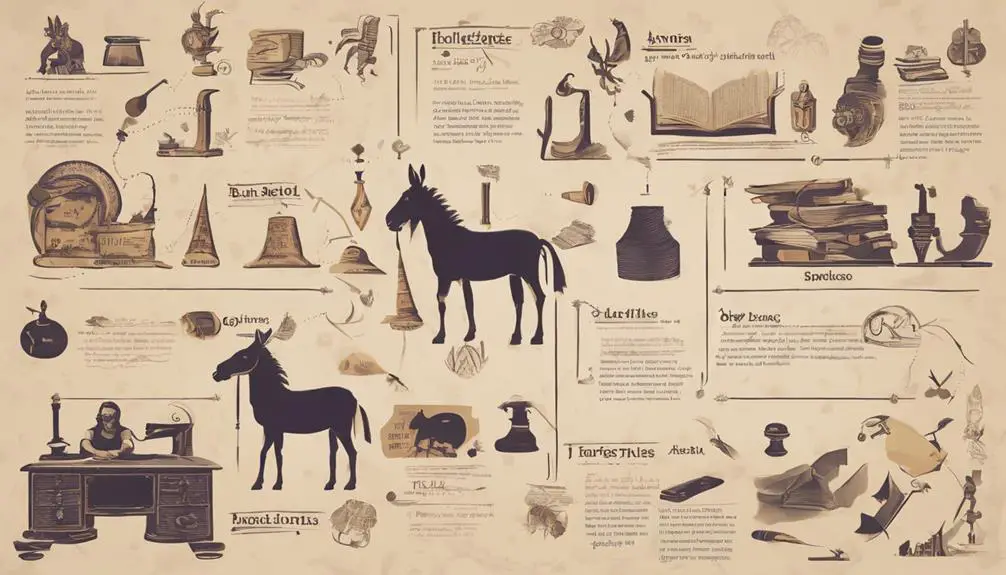Often misunderstood, the term 'ass' in the Bible holds deeper meanings worth exploring—discover what lies beneath this ancient text's surface.

Is the Word Ass in the Bible
When you're navigating through ancient texts, you'll often encounter language that might catch you off guard, such as the appearance of the term 'ass' in the Bible. It's important to understand this isn't the crass expression you might think it is today; rather, it refers to a domesticated beast of burden.
This exploration invites you to consider the historical context, the cultural misunderstandings that arise from evolving language, and what lessons can be drawn from these biblical mentions. There's much to unpack about why this term was used and how its interpretation affects our understanding of biblical teachings.
So, let's set off on a journey to uncover the layers beneath this seemingly simple word.
Key Takeaways
- The term 'ass' indeed appears in the Bible, symbolizing humility and service.
- Accurate translation and understanding of 'ass' reveal its significant symbolic meaning.
- Interpretation of 'ass' in biblical texts requires awareness of historical and cultural contexts.
- Translation challenges emphasize the need for scholarly work to ensure accurate biblical interpretations.
Historical Context of 'Ass

How has the term 'ass' evolved within historical contexts, especially when referenced in biblical scriptures? Initially, this term referred to a domesticated beast of burden, integral to the societies depicted. Its significance goes beyond mere utility; it's steeped in rich animal symbolism. In ancient times, the 'ass' symbolized peace, humility, and simplicity, contrasting the horse, often associated with war and nobility. This distinction is pivotal in understanding biblical narratives and the roles animals played in them.
However, the translation challenges from ancient languages to modern English have complicated the term's interpretation. The original texts used specific words to denote the 'ass,' but as languages evolved, so did the connotations of these words. Today's colloquial use of 'ass' diverges significantly from its historical and biblical usage, leading to potential misunderstandings of the text. It's crucial to approach these translations with an awareness of the historical and cultural contexts that shaped them. This understanding not only enriches the reading of biblical scriptures but also highlights the complexity of language evolution and its impact on animal symbolism within these sacred texts.
Biblical References Explained

Numerous biblical passages feature the 'ass' within their narratives, each offering unique insights into the cultural and spiritual landscapes of the times. This term, historically accurate and contextually rich, symbolizes more than just a domesticated beast of burden. In understanding these references, you delve into a world where animal symbolism plays a pivotal role in conveying spiritual truths and societal norms.
The accuracy of translation is paramount in grasping the full essence of these biblical mentions. 'Ass' in ancient texts genuinely refers to what modern readers understand as a donkey, an animal esteemed for its endurance and humility. This precision in translation unveils layers of meaning, allowing you to appreciate the subtleties embedded within scriptural stories. For instance, an 'ass' being present at pivotal moments isn't merely incidental; it embodies traits revered by the communities narrating these tales.
Through scholarly analysis, it becomes evident that each mention of the 'ass' is a deliberate choice, enriching the narrative with cultural and religious significance. The animal's presence often signifies humility, service, or a divine intervention, underscoring the depth of thought behind every word in these ancient texts. This careful consideration ensures that the biblical references to the 'ass' aren't only accurate but resonate with profound symbolic importance.
Cultural Misunderstandings

Often, the term 'ass' in biblical contexts is misinterpreted by contemporary audiences, leading to cultural misunderstandings that obscure the text's original significance. You might find that modern interpretations of ancient texts are fraught with challenges, especially when language has shifted so dramatically over millennia. The word 'ass', historically referring to a domesticated beast of burden, now carries a vastly different connotation in contemporary English, primarily due to evolving language usage and societal norms.
These translation challenges contribute significantly to the difficulty in grasping the original intent and meaning behind biblical passages. As you delve deeper, it becomes apparent that without a clear understanding of the historical and cultural backdrop against which these texts were written, modern readers are at risk of misinterpreting the significance of such terms. This gap in comprehension often leads to a skewed perception of the biblical narrative, potentially diminishing the richness and depth of the spiritual and moral lessons intended.
Moreover, the reliance on translations that may not fully capture the nuances of ancient languages further complicates the issue, underscoring the importance of scholarly work in bridging these cultural and linguistic divides. Understanding these dynamics is crucial for anyone seeking to engage with biblical texts in a meaningful way.
Language Evolution Over Time

Understanding the challenges posed by translation and cultural misunderstandings, it's critical to examine the evolution of language over time to fully appreciate the complexity of biblical texts. As you delve into ancient scriptures, you'll quickly encounter translation challenges that stem from the vast differences between ancient languages and today's vernacular. Modern slang, in particular, has shifted dramatically, influencing how we interpret words and phrases that were once common.
To navigate these complexities, consider the following key points:
- The meanings of words can significantly change over centuries, leading to potential misinterpretations.
- Ancient languages often have multiple meanings for a single word, unlike the more specific terms in modern languages.
- Cultural contexts play a crucial role in understanding the original intent behind words and phrases.
- Advances in linguistic research continually refine our understanding of ancient texts.
- The reliance on earlier translations can perpetuate inaccuracies if not carefully re-examined with modern linguistic insights.
Grasping these aspects of language evolution helps you appreciate the nuance and depth of biblical texts, beyond the surface-level understanding that may first appear. It's a journey through history, culture, and linguistics that enriches your comprehension of these ancient writings.
Lessons From Biblical Usage

Delving into the biblical usage of words, you'll uncover pivotal lessons on the fluidity of language and its impact on interpretation. The term "ass" in the Bible, primarily referring to a domesticated beast of burden, offers a fascinating case study in both symbolic interpretations and translation differences. This exploration not only illuminates the specific cultural and historical contexts but also invites a broader reflection on how language shapes our understanding of sacred texts.
Aspect |
Significance |
|---|---|
Symbolic Interpretations |
The "ass" symbolizes humility and service, reflecting deeper spiritual messages within the narrative. |
Translation Differences |
Variations in translation can alter the perceived meaning, highlighting the importance of linguistic nuances in biblical interpretation. |
These insights encourage a meticulous approach to reading and interpreting the Bible. You're prompted to consider not just the literal meaning but also the symbolic value and cultural significance of the words used. This analysis reveals how translation choices can significantly affect our understanding of biblical stories and teachings. As you delve deeper into these aspects, you develop a more nuanced appreciation for the complexities of biblical language and its interpretation, underscoring the ongoing dialogue between the text, its translators, and readers across centuries.
Frequently Asked Questions
How Do Modern Translations of the Bible Address the Term "Ass" Compared to Older Translations?
Modern translations tackle the term 'ass' with attention to language evolution and translation methodology. You'll find that contemporary versions often opt for 'donkey' to reflect current language usage, avoiding potential misunderstandings.
Older translations stuck closely to literal interpretations, preserving the term 'ass.' This shift highlights a broader trend in translation practices, aiming for clarity and accessibility without sacrificing accuracy.
It's a delicate balance, reflecting scholarly efforts to engage modern readers while honoring the text's original context.
Have There Been Any Significant Controversies or Public Debates Regarding the Inclusion or Translation of the Word "Ass" in the Bible?
You might wonder if there's been uproar over certain words in historical texts. Specifically, translation methodology and language evolution have sparked discussions, but no major controversies have arisen from the word 'ass' in biblical translations.
Scholars focus on conveying the original meanings accurately, understanding that language changes over time. Thus, while debates on translation accuracy are common, they've rarely centered on this term specifically, underscoring a scholarly, objective approach to biblical language.
How Do Children's Bibles or Simplified Versions of the Scripture Handle Verses That Contain the Word "Ass"?
When tackling verses with the term 'ass,' children's Bibles and simplified scriptures face translation challenges and require educational adaptations. You'll find that these versions often opt for words like 'donkey' to maintain clarity and appropriateness for young readers.
This approach helps in navigating the delicate balance between staying true to the original texts and ensuring the content is accessible and suitable for children, reflecting a thoughtful consideration of language and audience in religious education.
Are There Differences in the Perception or Acceptance of the Word "Ass" in the Bible Across Different Christian Denominations or Cultures?
Yes, there are differences in how various Christian denominations and cultures perceive or accept the word 'ass' in the Bible. These variances stem from language evolution and cultural semantics, which influence the interpretation and sensitivity towards certain terms.
Over time, words change in meaning and connotation, leading to diverse reactions and adaptations within religious texts. It's crucial to understand these nuances to fully grasp the historical and contemporary contexts of biblical language.
How Has the Depiction of the Term "Ass" in Biblical Stories Influenced Its Portrayal in Religious Art and Literature Outside the Bible?
You'll find that the depiction of the term 'ass' in biblical stories has greatly influenced its portrayal in religious art and literature. This influence stems from the rich animal symbolism associated with the term, shaping artistic interpretation across various cultures.
Scholars argue that this has led to a nuanced understanding of the term in religious contexts, enhancing its symbolic significance in both art and literature beyond the biblical narrative.
Conclusion
In conclusion, you've seen how the term 'ass' in the Bible, historically referring to a domesticated animal, illustrates the nuances of language evolution and cultural misunderstandings.
Through biblical references, it's clear that the word's context significantly differs from contemporary offensive connotations. Analyzing its usage offers valuable lessons on interpreting ancient texts within their original linguistic and cultural frameworks.
Thus, understanding the term's biblical role enhances our comprehension of historical texts and the importance of context in language.



Sign up